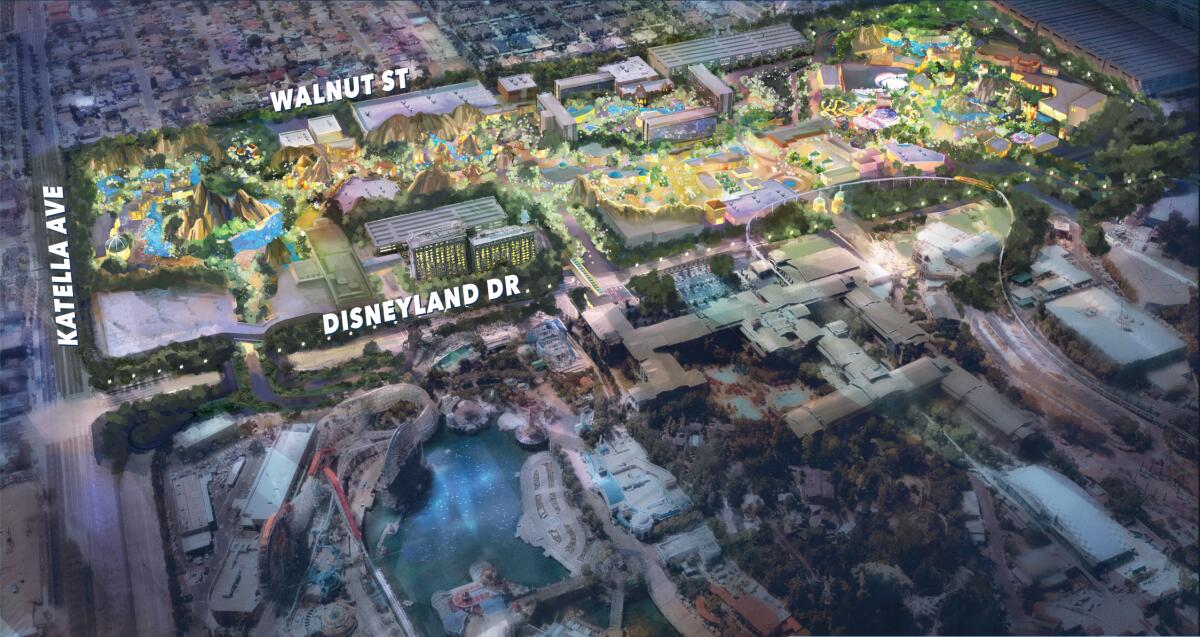An economic report touts Disneyland’s expansion. Why can’t the public read it?

- Share via
The Anaheim City Council unanimously voted to move forward on Tuesday with the biggest expansion of the Disneyland Resort in nearly 30 years.
Channeling Walt Disney, who once said the work of Disneyland would “never be completed,” Disney officials are one step closer to securing at least $2 billion in new development within 10 years with final approval scheduled for May 7.
Dubbed “DisneylandForward,” the expansion calls for granting the company greater flexibility through relaxed zoning to transform surface parking lots into new themed lands, attractions, hotels and entertainment within 490-acres of existing Disney properties through the next 40 years.
Ahead of Tuesday’s council meeting, an economic impact report from Cal State Fullerton touted the benefits of Disney expansion.
According to a nine-page executive summary, a full build-out of Disney theme park, hotel and vacation club entitlements would bring a “dramatic increase in tax revenue” to Anaheim. The projected $244 million a year from such expansion would double Disney’s current fiscal contribution to the city.
Despite the rosy forecast, the complete report from the Woods Center for Economic Analysis and Forecasting at Cal State Fullerton hasn’t been made publicly available — a chief concern among residents critical of the Disney expansion plan.
The Anaheim Planning Commission voted Monday night to approve the DisneylandForward project, which would clear the path for major park development.
“We need to see the study if it’s the only justification for the city to completely leapfrog over negative impacts from DisneylandForward,” said Cynthia Ward, a longtime Anaheim resident and former mayoral candidate. “Why would the city even consider signing any of this if Disney withholds that report from us?”
Mike Lyster, a city spokesperson, said Anaheim asked Disney for the complete report but was told by the company that it included proprietary information.
The city obtained the report’s executive summary, instead, which it made publicly available.
“The summary is fairly detailed,” Lyster added. “We would point to more than 20 years of experience that tells us when the parks expand, we will see more revenue that we turn around and use for police, fire, community centers, libraries, and all the things we do for residents.”
Carolina Mendez, an Anaheim resident and member of Chispa, a Latino advocacy group, asked the city for documents regarding any discussion of the report, especially between council members.
“Ultimately, at its core, it’s yet another question of transparency,” Mendez said. “This economic study was cited constantly throughout this process.”
All she received in return was an email exchange in March where the CEO of Spectrum Development Group provided city staff with a copy of the executive summary.
TimesOC requested comment on the study from all Anaheim council members. None responded by press deadline.

Anil Puri, co-director of the Woods Center, said that report was commissioned by Disney for $150,000, half of which was spent on university overhead and software purchases. The rest of the money was divided among three researchers and a grad student to compensate their labor.
“It is commonplace for businesses to commission studies with independent third parties, often universities,” said Suzi Brown, a Disneyland Resort spokesperson. “We are fortunate to have the highly respected CSUF Woods Center in our own backyard to conduct this study regarding the economic benefits of DisneylandForward.”
DisneylandForward’s website touts the report as an “independent economic analysis.” The company provided the Woods Center with data on, among other things, construction spending, worker wages and taxes.
But Brown cited proprietary and competitive information included in the study as reasons why a complete copy of it could not be provided to TimesOC.
In response to a TimesOC public records request, Cal State Fullerton also withheld the report, including the executive summary.
Anne Grogan, a records access officer at Cal State Fullerton, cited two provisions.
She claimed that disclosing the report was outweighed by the public’s interest in keeping it secret. The study was also withheld on the grounds that state laws prohibit making records containing intellectual property, trade secret or copyright information public.
Interviews and records provide a rare insider’s look at the influence of unelected power brokers in the city that is home to Disneyland and the Angels.
Karl Olson, a San Francisco-based attorney who specializes in the California Public Records Act, doesn’t think the university’s claims for withholding the report are valid.
“The CSU system, in general, has an abysmal record when it comes to transparency,” he said. “The first claim they make is the so-called ‘catch all’ exemption, which basically admits they don’t have any real exemptions but will invent that one, because they don’t want to give up the report.”
Olson added that it’s very hard to make a trade secret claim and that Cal State Fullerton’s “extremely terse denial” of records doesn’t establish that case.
“The government has a duty to make available any reasonably segregable portion of a record while redacting anything that might be exempt,” he said, “but they’re not supposed to just blanket deny the whole thing.”
With the absence of the full report, Mendez is calling on council members to reconsider.
“This is a litmus test for a city council,” she said. “We have council members in office right now who’ve made it a point to campaign on transparency and accountability. As residents, we expect them to prove their commitment now.”
A mailer sent to Anaheim residents by Disney ahead of the vote touted DisneylandForward as an initiative that would strengthen city services by bringing $202 million in additional tax revenue to the city in the first 10 years alone.
The mailer cited the Woods Center study for the claim, but no such statistic appears in the executive summary.
In addition to the projected revenue, DisneylandForward is pledging to invest $30 million in affordable housing and $8 million in park improvements among its community benefits.
Disney attached a postage-paid letter with the mailer for residents to ask Anaheim Mayor Ashleigh Aitken and council members to support its expansion plan.
The company told TimesOC the 10-year tax revenue figure was based on calculations from the study finding that every $1 billion invested by Disney generates about $11 million in tax revenue for Anaheim during a four-year construction period and $15 million annually after construction.
“Disney is trying to rally residents to support their projects using numbers we can’t fact-check,” Ward said. “They need to disclose the report so that we can see where they got those numbers from.”
All the latest on Orange County from Orange County.
Get our free TimesOC newsletter.
You may occasionally receive promotional content from the Daily Pilot.






